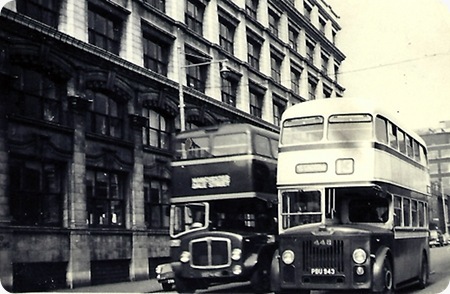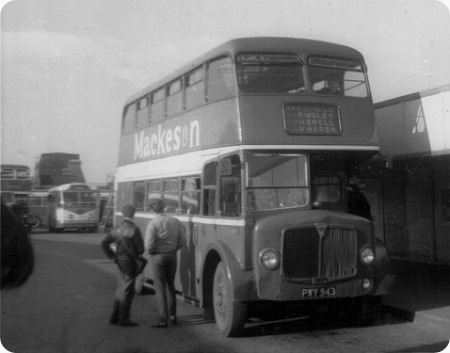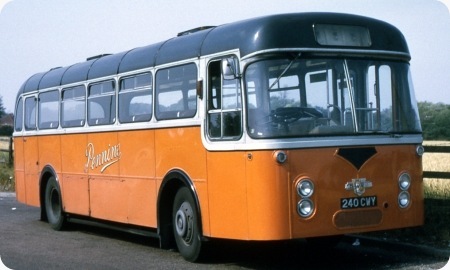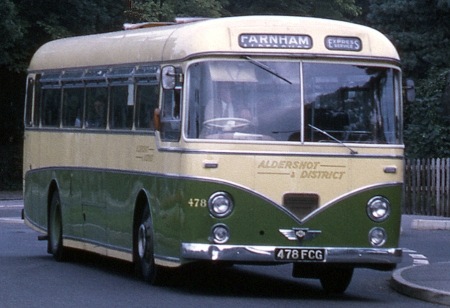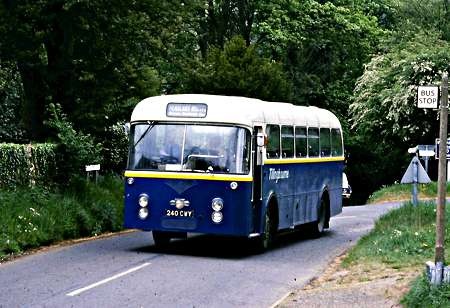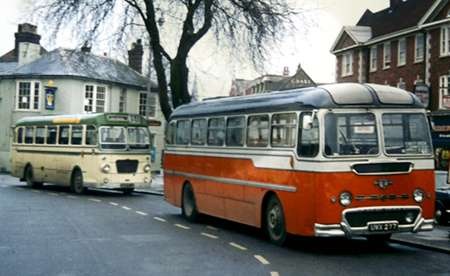Oldham Corporation – Leyland Titan – PBU 943 – 443
Oldham Corporation
1958
Leyland Titan PD2/30
Roe H37/28R
I have been having a rummage through a few pictures and came across this one. Whilst it is not the best photograph in the world, I am sure it is of historical interest.
The vehicle on the right is one of Oldham Corporations 1958 ‘Tin front’ Titans fleet number 443, it was transferred to SELNEC on November 1969, and re-numbered 5343 in that fleet. In this photograph it is still in the Crimson and White lined out livery, which Oldham used until 1966, when replaced with Pommard and Devon Cream. It is photographed in Lever Street Manchester, (destination blinds showed Stephenson Square), operating the service 13 to Uppermill via Oldham and Scouthead. This service was a Limited Stop service operated jointly with Manchester Corporation Transport.
What is interesting with the photograph is that I caught a Maynes of Manchester AEC Regent operating on their service between Droylsden and Manchester Dale Street. Unfortunately the speed of the bus has made the registration unreadable, and there is no record on the rear of the photograph. But it looks like one of their AEC Regent V, with Park Royal H41/32R bodies.
Photograph and Copy contributed by Stephen Howarth
A full list of Titan codes can be seen here.
———
06/11/11 – 12:25
Aah, my favourite vehicle from my favourite batch of Oldham’s buses. These PD2s were superb inside and out, but sadly got more and more disfigured over the years with moquette seats replaced by vinyl ones and the original elaborately lined-out livery changing first to an unlined version, then pommard and cream and finally, for some, SELNEC’s orange and white.
443 escaped some of these treatments. As the batch were being worked through for re-certification when twelve years old the policy was changed so the earlier examples received orange and a five year ticket. 443 was done later and only got three years in total. To cut down on costs it wasn’t fully repainted but tidied up in pommard. This work was done at Stockport and as a consequence the original interior survived largely intact.
It survived a bit longer as it was used as a skid pan bus at Hyde Road for a while after withdrawal. I have a photo of it there carrying the grille (and therefore registration) off 442 – very confusing!
The Mayne’s bus will be on the Audenshaw to Dale Street service – the Droylsden service was numbered 46 and more significantly, ran to Stevenson Square, although both traversed this section of Lever Street. It can be identified as 6974 ND, a 1961 AEC Regent V 2D3RA with Park Royal H41/32R body of a particularly ugly design.
The photograph will have been taken just before quarter past the even hour, as that is when Oldham’s bus on the 13 left, the other bus after the odd hour being a Manchester one. North Western worked the opposite way round to Uppermill via Lees on the 14, then returning via Scouthead to Manchester as a 13.
David Beilby
———
06/11/11 – 17:03
A close colleague of the (A) Mayne’s bus is already on this site at this link. Doesn’t it look like a Bridgemaster – & the height is not all perspective, has it – no dome?
Joe
———
07/11/11 – 07:39
It’s exactly the same as the second Bridgemaster body – except, obviously, for the height. If you mean does it have a flat roof profile, the answer is yes.
David Oldfield
———
07/11/11 – 07:40
As David B said, the Park Royal bodies on that batch of Maynes Regent Vs were particularly ugly, and they were the last ones bought before Maynes switched to East Lancs. As an enthusiast I have always liked to think there is a connection between those two facts, but I have no evidence for this.
Peter Williamson
———
07/11/11 – 12:11
Well the East Lancs bodies were a distinct improvement aesthetically – but were they East Lancs or Neepsend?
David Oldfield
———
08/11/11 – 06:40
I agree with David Beilby, these Oldham PD2’s always exuded an air of quality with their comfortable interiors and lined out livery. I rode on them regularly on the 9 (Rochdale-Oldham-Ashton) and 24/90 (Rochdale- Manchester) routes. On the 90 Limited Stop service which ran non-stop from Royton into Manchester they could turn in a fair pace along Broadway if they got the many sets of traffic lights in their favour.
Regarding the ugly Park Royal bodies on the Maynes AEC, I did once read somewhere that Southampton turned away from Park Royal and moved to East Lancs after being very unimpressed with the abominations Park Royal inflicted on them on both Leyland PD2 and AEC Regent V chassis using the Bridgemaster derived design. I don’t know if this was true or even if operators cared about the appearance of their buses from a design point of view. Perhaps some did.
Philip Halstead
———
08/11/11 – 10:45
Well Philip, they certainly forsook the same PRV abominations for East Lancs/Neepsend – whatever the reason. [Swindon, Yorkshire Traction and Yorkshire Wooken also had versions – the latter two by Roe – not to mention the first ACV Atlanteans, again built by Roe.]
David Oldfield
———
10/11/11 – 07:37
Similar very ugly Park Royal bodies were bought on a batch of PD2s by Southampton. These seemed incredibly top heavy due to their short length.
Chris Hough
———
10/11/11 – 07:38
I am sure that the Southampton story is true. Possibly not all, but certainly many municipal General Managers had definite ideas about the standards of vehicle design and appearance. Inevitably, the name of Geoff Hilditch springs to mind, but he was by no means alone in holding such views, and the municipal GMs held regular get togethers at which opinions were frankly exchanged. I have some Southampton pictures that I will submit in due course.
Roger Cox
———
10/11/11 – 07:39
To answer David’s question, Maynes had two Regent Vs bodied by East Lancs in 1964 and three by Neepsend in 1965.
Peter Williamson
———
10/11/11 – 17:02
Thanks, Peter
David Oldfield
———
20/12/11 – 06:40
I too agree with David Beilby’s comments about the Leyland/Roe Titans 429-452. I remember riding on them to and from college/Oldham Music Centre, on the 9 (409) bus route (437,443 and 449) in the mid 1960’s when they still carried their original livery. Around 1964/5 I recollect seeing a few examples on our route (B, Fitton Hill-Middleton Junction), and off their usual routes. It was the elaborate lined livery which caught my eye, as the usual buses on this route were unlined by that time or indeed like Leylands 388-407 and 413-418 (NBU 488-507 and NBU 513-518), never had been. I used to take notes of the bus numbers over a period of twelve months in 1964/5. I rode on 432,433,438,446,447,448,451 and 452 – to and from school in Fitton Hill. Since they were used primarily on the trunk routes I couldn’t understand why; even so, with their increased seating capacity of 65 they were a welcome sight. By this time they were looking tired (435,440 and 452 particularly so) and before long a simplified livery was applied-what a disappointment!
By mid July 1966 they were introduced to our route in number, having been cascaded from the trunk routes when the Leyland Atlantean invasion gained ground.
D. Butterworth
Quick links to the - Comments Page - Contact Page - Home Page
